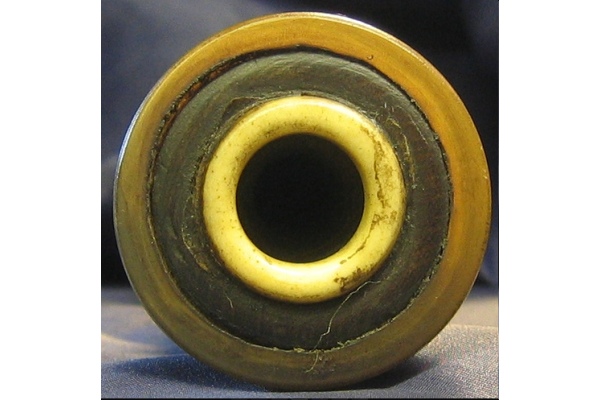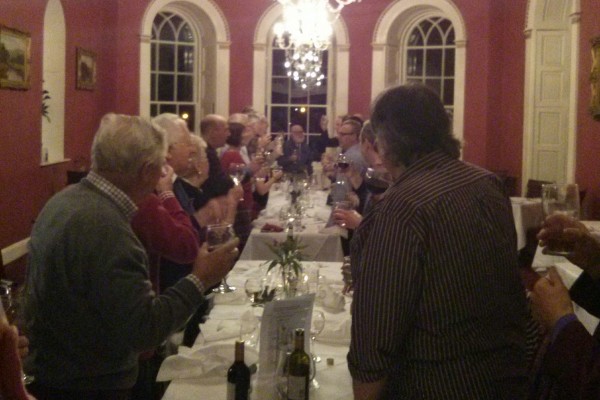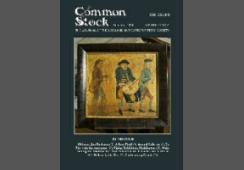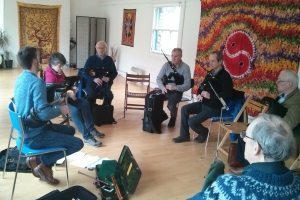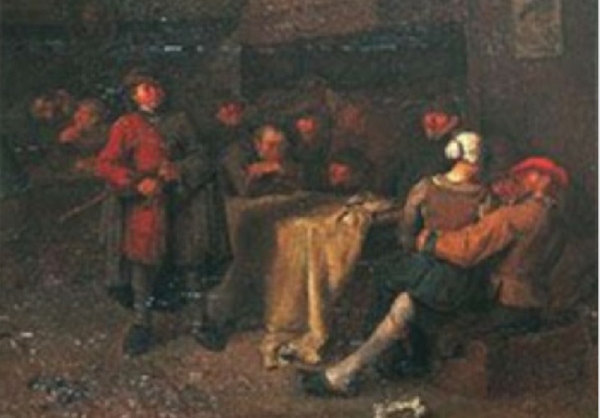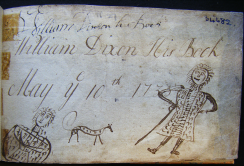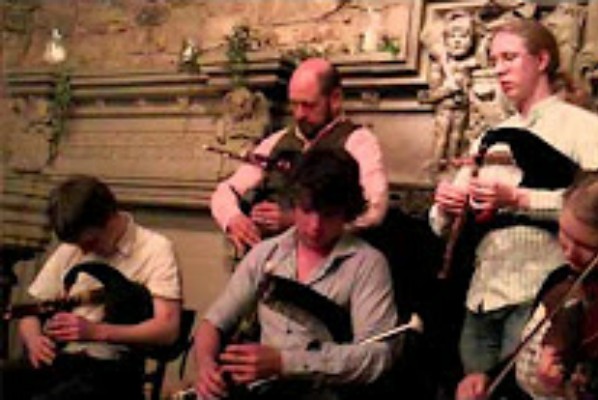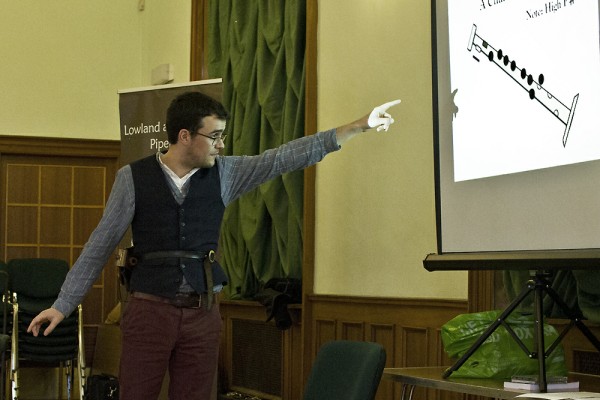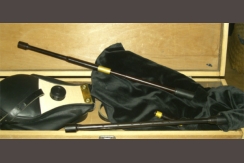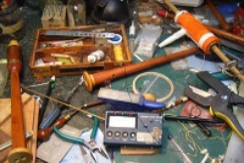The following pages were published in the June issue of Common Stock in 1997. They are reproduced here, followed by some new comments on the content, and reasons why the material described might benefit from being revisited - for it contains information which has never been assimilated or properly considered.
Extract from Vol 3 of ENCYCLOPAEDIA PERTHENSIS (23 volumes of which were published in Perth between 1796 and 1806, which makes it highly likely this extract was written prior to 1800)
Andy Hunter, who ‘discovered’ the encyclopaedia entry, makes the following comments and observations.
1. The definition of bagpipe which heads the article is taken word for word from Dr Samuel Johnson's Dictionary of The English Language. London 1785.*
The types of pipe mentioned which are of specific interest to our Society are, Highland, Lowland, Small pipe and Shuttle pipe. The article seems to imply strongly a case for affinity between the Highland and Lowland pipes with a clear assertion that they possess a repertoire peculiar to themselves and peculiar to Scotland. There is a difference in repertoire and function, but not so great that a Lowland piper would not have made his way to Skye to learn advanced gracing and be in a position to "improve" Lowland. piping; it also comments dismissively on the eclectic repertoire of the shuttle and small pipe. Although the author does not state that the small pipe with closed chanter and the shuttle pipe are not Scottish, the music played upon them (music not "peculiar" to themselves) do not represent a self-contained and self-conscious tradition in the way that Highland and Lowland pipes do. (It is worth noting that no mention is made of the "pastoral" pipe; perhaps due to the fact that the references to Irish pipes would cover this. However the author could have made the same remarks about an eclectic repertoire as rightly identified by John Goodacre at the Peebles CoIlogue a few years back.)
3. I am persuaded that we may be looking at yet another tantalisingly brief glimpse of the Lowland piobraichead or a classical form of piping peculiar to the Lowland pipe. Why would the Lowland piper go to Skye if he did not wish to improve his already proven skills by more complex gracing? Did he wish to learn a completely different tradition (and why would the Highlanders tolerate an outsider") l am at least partially persuaded that he also has something which was akin to piobraichead which the Highlanders themselves respected i.e. a piping tradition which was based on structured variations on a theme, undoubtedly supplied by good solid Lowland airs. (In this respect I never fail to be impressed by the version of Soar Plooms of Galashiels as published and played by Gordon Mooney, with its beautiful progression through its variations). Stunningly, given the past debates within our Society, the theses put forward by some of [a] hunch over the existence of a "classical" Lowland piping tradition, Allan MacDonald's iconoclastic but well founded views on the role of the singing tradition and Highland piobraichead, Matt Seattle's convincing theories of pipe music and the identifying criterion of variations, and lastly my own feeling that what we now refer to as Border pipes should historically be referred to as Lowland pipes (as in the article) and that any other variation relying principally on drone combinations differing from the two tenor and bass configuration be termed fairly "Border" pipes.
4. The Highland piobraichead begins with a "tune" (the theme is often referred to in this way by Highland pipers), Allan MacDonald makes a sound case for this tune being sourced in song and perhaps further back in harp music; the variations become varia tions relying mostly on change of tempo and a build up of gracings. The Lowland classical piece would be also a "tune" but the variations would be a melodic progression in the wider European tradition.
5. So what's new in the debate surrounding our various traditions! At the end of the 18th century a contributor to a Scottish Encyclopaedia exhibiting a strong Scottish bias makes the case for a Scottish Highland and a Scottish Lowland tradition in piping; small pipes and shuttle pipes are not part of this tradition (although their eclectic repertoire may include popular Scottish pieces among others). He also states that the Highlanders have it with sophisticated gracing. We also have a case of a piper straddling two tradi tions no doubt in the same way as the gypsy, Allan and the master piper, Dixon bridged other traditions in their own day. Today we have extremely talented Highland pipers adopting the bellows pipes as another string to their bow (there is no evidence to date of any attraction towards the Lowland repertoire per se), but maybe we should just be glad we have a living tradition and get on with making music.
(Ed. There now follows the text which Andy Hunter encountered in the Perth Encyclopedia)
(I.)* BAGPIPE. n. [from; bag and pipe ; the wind being received in a bag.] A musical instrument, consisting of a leathern bag, which blows up like a football, by means of a port vent or: little tube fixed to it, and stopped by a valve; and three pipes or flutes, the first called the great pipe or drone, and the second the little one; which pass the wind out only at the bottom; the third has a reed, and is played on by compressing the bag under the arm, when full; and opening or stopping the holes, which are eight, with the fingers. The bagpipe .takes in the compass of three, octaves. [-]
(2.) BAGPIPE FARTHER DESCRIBED. The peculiarity of the bagpipe, and from which it takes its name, is that the air which blows it is collected into a leathern bag, from whence it is pressed out by the arm into the pipes, These pipes consist of a bass, and tenor or rather treble; and are different according to the species of the pipe. The bass part is called the DRONE, and the tenor or treble part the CHANTER. Bagpipes are chiefly used in Scotland and Ireland In all the species, the bass never varies from its uniform note, and therefore very deservedly gets the name of drone; and the compass of the chanter is likewise very limited. There is a considerable difference between the Highland and Lowland bagpipe of Scotland; the former being blown with the mouth, and the latter with a small bellows: though this difference is not essential, every species of bagpipe being capable, by a proper construction of the reeds, of producing music either with the mouth or bellows. The species of bagpipes most commonly known in this country, are as follows:
I. BAGPIPE, HIGHLAND. This consists of a chanter and two short drones, which sound in unison the lowest note of the chanter except one. This is exceedingly loud, and almost deafening, if played in a room; and is therefore mostly used in the fields, for marches, &c. It requires a prodigious blast to sound it; so that those un accustomed to it cannot imagine how Highland pipers can continue to play for hours together, as they are often known to do. For the same reason, those who use the instrument are obliged either to stand on their feet or walk when they play. The instrument hath but 9 notes; its scale, however, hath not yet been reduced to a regular standard by comparing it with that of other instruments, so that we can say nothing about its compass. Those who are better acquainted with it, however, affirm that it plays only the natural notes, without being capable of variation by flats or sharps.
II. BAGPIPE, IRISH This is the softest and in some respects the most melodious of any, so that music books have been published with directions how to play on it. The chanter, like that of all the rest, has eight holes like the English flute, and is played on by opening and shutting the holes as occasion requires; the bass consists of two short drones, and a long one: The lowest note of the chanter is D on the German flute, being the open note on the counter string of a violin; the small drone (one of them commonly being stopped up) is tuned in unison with the note above this, and the large one to an octave below; so that great length is required in order to produce such a low note, on which account the drone hath sometimes two or three turns. The instrument is tuned by lengthening or shortening the drone till it sounds the note defined.
III. BAGPIPE, SCOTS Lowland, is also a very loud instrument, though less so than the former. It is blown with bellows, and hath a bass like the Irish pipe. This species is different from all the rest, as it cannot play the natural notes, but hath F and C sharp. The lowest note of a good bag pipe of this kind is unison with C sharp on the tenor of a violin tuned concert pitch; and as it hath but 9 notes, the highest is D in alt. From this peculiar construction, the Highland and Lowland bagpipes play two species of music essentially different from one another, as each of them also, is from every other species of music in the world. Hence these two species of bagpipes deserve notice as. curiosities; for the music which they play is accompanied with such peculiar ornaments, or what are intended as such, as neither violin, nor even organ, can imitate, but in a very imperfect manner. This kind of bagpipe was formerly very much used in Scotland at weddings and other festivals; being indeed extremely well calculated for playing that peculiar species of Scots music called reels. It has been often a matter of surprise how this was possible, as the instrument has only a compass of 9 or 10 notes at the utmost, and which cannot be varied as in other instruments. In this respect, however, it has a very great compass, and will play an inconceivable variety of tunes. As its notes are naturally so high, there is scarce any one tune but what is naturally transposed by it, so that what would be a flat note on the key proper for the violin, may be a sharp one on the bagpipe; and though the latter cannot play any flat note, it may nevertheless in this manner play tunes, which on other instruments would be flat, to as great perfection these instruments themselves.
IV. BAGPIPE SMALL, is remarkable for its smallness, the chanter not exceeding 8 inches in length; for which reason, the holes are so near each other, that it is with difficulty they can be closed. This hath only 8 notes, the lower end of the chanter being commonly stopped. The reason of this is, to prevent the slurring of all the notes which is unavoidable in the other species; so that in the hands of a bad playe; they become the most shocking and unintelligible instruments imaginable: but this, by having the lower hole closed, and also by the peculiar way in which the notes are expressed, plays all its tunes in the way called by the Italians staccato. It hath no species of music peculiar to itself; but can play nothing which cannot be much better done upon other instruments; though it is surprising with what volubility some performers on this instrument will display, and how much they will overcome the natural disadvantages of it. Some of this species, instead of having drones like the others have their bass parts consisting of a winding cavity in a kind of short case, and are tuned by opening these to a certain degree by means of sliding covers; from which contrivance they are called shuttle pipes.
(3.) BAGPIPES ANTIQUITY AND EFFECTS OF. (4.) BAGPIPES, ORIGIN OF.
[While these sections are of historic interest, I have omitted it here, since it adds nothing to the argument]
(5.) BAGPIPES, THE GERMAN, ITALIAN, ORGAN &c. have nothing different in their construction from these above described, nor any peculiar good quality to recommend them.
(1.) * BAGPIPER. n./: [from bagpipe.] one that plays on a bagpipe.-Some that will evermore peep thro' their eyes, And laugh, like parrots, at a bagpiper Shakespere,
(2.) BAGPIPERS, COLLEGE OF. Formerly there was a kind of college in the island of Sky where the Highland bagpipe was taught; the teachers making use of pins stuck into the ground instead of musical notes. This college. however, has been for some time entirely dissolved, and the use of the Highland pipe became much less general than before. At last a Society of gentlemen, thinking it perhaps impolitic to allow the ancient martial music of the country to decline, resolved to revive it by giving an annual prize to the best performers on the instrument. These competitors only surviving member of the ancient college of Sky is now professor of bagpipe music. The Lowland bagpipe was reformed and the music improved by George Mackie, who is said to have attended the college of Sky 7 years. He had before been the best performer on that instrument in that part of the country where he lived; but, while attending the college at Sky, he adapted the graces of the Highland Music to the Lowland pipe. Upon his return, he was heard with astonishment and admiration; but unluckily, was not able to commit his improvements to writing. and indeed the nature of the instrument scarce admits of it.”
So much for the Encyclopedia Perthensis; it is a fine example of the kind of practices which were common in the publishing industry at the time, for it is taken verbatim from a publication which was by the time this was printed some 25 years old - I refer, f course, to the second edition of the Encyclopedia Britannica, all the early editions of which were prepared, printed and published in Edinburgh. Andy Hunter was correct in saying that the definition of a bagpipe is taken verbatim from Johnson’s dictionary, but Johnson too had done his own borrowing. (Johnson’s original definition, in the 1755 edition, reads “A muſical inſtrument, confifting of a leathern bag,
and pipes”
However that may be, the truly arresting thing about this article is the paragraph describing the ‘:Lowland Bagpipe’. The first volumes of the 2nd edition of the EB were published in 1776, and this, to the best of my knowledge is the first time the name ‘Lowland Bagpipe’ appear anywhere. Andy Hunter seems to have passed quickly over this description, for he makes no comment on it. It’s worth repeating, since no-one else has ever commented on it either. Having said that this bagpipe is ‘ a very loud instrument, though less so than the former’, the author goes on to say “This species is different from all the rest, as it cannot play the natural notes, but hath F and C sharp. The lowest note of a good bag pipe of this kind is unison with C sharp on the tenor of a violin tuned concert pitch; and as it hath but 9 notes, the highest is D in alt.”
Let’s look at that in detail; the ‘tenor’ string of a violin is not, as I first thought, the D string, but the A. (The D string was called at the time the ‘counter’, as our author mentions in the description of the Irish pipe). The term ‘in alt’ meant ‘above the stave’. What this means is that the lowest note on this chanter was the same pitch as the C# on a Highland chanter, and the highest was a fourth above the A of the Highland chanter. Add to this that it ‘hath a bass like the Irish pipe’ and we have a description of a bagpipe quite unlike any other and the existence of which is vouched for by this one source alone.
And yet, here it is, described in detail and a suitable repertoire ascribed to it. What are we to make of this? The first question we might ask is, how credible is the article, that is to say, who was the author, and did they know what they were talking about, or were they merely copying another source? We can have no idea now who pirated the Perthensis work, (the 1818 edition was ‘Printed for John Brown, Edinburgh’) but we do know who wrote most of the second edition of the Encyclopedia Britannica - it was one James Tytler.
In the Masonic Lodge of St John in the Canongate in Edinburgh there is a notorious painting depicting the ‘inauguration of Robert Burns as poet Laureate of the masons of Scotland’. Opinion seems still to be undecided as to whether any such event ever took place; that need not concern us; what is important is that there also exists a cartoon of this painting with outlines of all the personages depicted with a key to their names; In what seems to be a ‘musicians’ gallery’ at the rear of the room a number of figures are clamouring for space; one of them, who is leaning over the right-hand corner of the gallery has a set of bagpipes with two long drones held horizontally over his left arm; the cartoon identifies him as James Tytler.

The painting was done around 1840, I believe, and Tytler died in Salem, Massachusetts in 1804; the artist has clearly taken his clue from the brief biography of Tytler that was included by Robert Cromek in his ‘Reliques of Robert Burns’ but which was written by Robert Anderson, who knew Tytler well, and who described how ‘he exhilarated his spirits at intervals, with a tune on the Irish Bagpipe, which he played with much sweetness, interposing occasionally a song of his own composition, sung with great animation.’ (Several songs in Johnson’s Scots Musical Museum are ascribed to him.)
I’ve reproduced Tytler’s entire entry here (apart from the ‘history’) to demonstrate that, for all the other bagpipes mentioned, his information is more precise and accurate than any other we have from previous sources (the first edition of the EB had about three or four lines under ‘bagpipe’). Why, then, should we assume that he was misguided over this one entry?
I should confess here that, after first encountering this entry I investigated Tytler’s credentials and discovered what an extraordinary life he led. As a result I embarked on a biography of him and in the process read a fair amount of what he wrote, and he wrote a very great deal (I’ve probably read more of it than anyone else ever has). He was, as Anderson put it, ‘a firm believer in the Christian revelation, and a zealous advocate of genuine Christianity’ but also a millenarian and revolutionary (he was a close friend of Thomas Russell and other Irish radicals of the era) and escaped transportation for publishing seditious literature by emigrating first to Ireland and later to Salem, Massachusetts. The fact alone that he was responsible for almost all of the ten volumes of the EB should suggest that this is no mere publisher’s hack that we are dealing with.
I can think of one reason only to justify questioning Tytler’s description - the fact that no such instrument has survived, whereas many of the sort that we assume to have been the 18th century one have done so, plus the fact that pictorial evidence, particularly from political cartoons, consistently shows Scottish figures playing an instrument that appears to match the one we know now. The only evidence I know of to support Tytler’s description is the ‘Preceptor’ that was published in 1818 that has all the musical examples notated in D rather than the more conventional A. This, however, was explicitly a Highland pipe tutor, although George Skene in his diary for 1729 mentions meeting ‘the famouos piper James Bell’, who played a ‘big’ pipe which is so flatt that it tunes to the violine’.
Tytler was born in a small hamlet near Forfar in what was then Angus, in Scotland’s North-east. Is it possible that the instrument he describes was in use there in his boyhood? (He was born in 1745 and left for Edinburgh in 1765.)
I would take Tytler’s description seriously but for one thing, the statement that ‘it hath a bass like the Irish pipe’. Were it not for that we would have a description of a bagpipe more or less identical to that played throughout western Europe for centuries, one similar to that played today in Galicia and identical to that made today by Julian Goodacre. But I am inclined to assume that Tytler does not mean that the bass drone was an E nearly three octaves below the chanter’s bottom D; he must be merely referring to the fact that it consisted of three drones in a common stock; that is to say, the bass would be a D, shorter than today’s bass A.
Tytler’s claim that ‘the Highland and Lowland bagpipes play two species of music essentially different from one another, as each of them also, is from every other species of music in the world. Hence these two species of bagpipes deserve notice as. curiosities; for the music which they play is accompanied with such peculiar ornaments, or what are intended as such, as neither violin, nor even organ, can imitated, but in a very imperfect manner’ further suggests that he was aware of the tradition of which he speaks, although his statement that ‘this kind of bagpipe was formerly very much used in Scotland at weddings and other festivals’ does seem to suggest that by his time it had become something of a rarity, and perhaps it is here that the solution to this riddle lies. For it is a feature of Tytler’s entries throughout the Encyclopedia that he makes reference to opinions and observations from other writers many of whose work was decades old by 1776. Was he then recalling piping from his childhood in Angus?

It is interesting to note how Tytler’s description went on being reproduced well into the 19th century. Here. For instance is James Thompson, sometime around 1835-40, in his Life of James Allen, when speaking of the ‘Northumberland pipe - anciently much used by the Borderers’, which he says is ‘like the Scots Lowland pipe’;
“It is blown with bellows and has a bass like the Irish pipe. It cannot play the natural notes, but in the improved form, has F sharp. The lowest note is in unison with D on a violin tuned concert pitch; and it has but fourteen notes, the highest being B in alt. From its peculiar construction, the music it plays is accompanied with such peculiar ornaments as neither violin nor even organ can imitate but in an imperfect manner. It is extremely well calculated for playing that rustic species of music called reels.”
Similarly, James Logan, in his The Scottish Gael, published in 1838, speaks of ‘the sharp Lowland pipe’ implying that in his view the chanter had sharp leading notes, as Tytler described.
In fact, Tytler’s entry for bagpipe was repeated in every edition of the Britannica I have seen up to 1842, the 7th; the 8th edition, 1854 made drastic changes. concentrating on the (dubious) history and removing most references to different types of pipes except for a passage on the Highland pipe, which reads “Sixty years ago several kinds of bagpipe were used in Scotland and the north of England; but we now seldom hear any others than the small Irish bagpipe blown with bellows and the great Highland bagpipes, or its smaller congener, which is used at dances, chiefly in the Highlands”.
This entry goes on to explain that the 'long drone' on the Highland Bagpipe is tuned an octave below the A of the chanter, and the two shorter ones in unison with the chanter's low A; “the chanter has a compass of nine notes, all natural, extending from the G on the second line of the treble stave to the A in alt.” suggesting that this author at least was seriously confused, perhaps by reading what Tytler says he had learnt from those ‘better acquainted with it’ than he himself. (Tytler’s deference here to these others further suggests that, though he admits to being less familiar with the Highland pipe, his knowledge of the Lowland pipe was his own.)
Is it possible to explain how a bagpipe such as Tytler describes could have disappeared so entirely, and be replaced by another which we believe to have existed at least by the end of the 17th century? I can think of only one possibility, and this is inspired by the opinion, recorded by Alexander Campbell in 1815, held by Thomas Scott, who, says Campbell was ‘decidedly of the opinion that the Border bellows-bagpipe was of Highland (or at any rate, the north-east coast) origin, as all the pipers with whom he was acquainted positively declared’. “This”, added Campbell, “is a remarkable fact, not generally known, and difficult of belief.”
The implication of allowing any truth to Scott’s opinions is that the ‘Lowland pipe’ as we know it now was adapted by players in the north-east from the highland pipe in its ‘small’ form, what 19th century makers called ‘half-size’ or ‘reel’ pipes. That bellows had been added by the 1780’s is borne out by the appearance in William Shaw’s Galic [sic] and English Dictionary of the term ‘piobshionnaich - a pipe blown with bellows’.
What, then, are we to make of all this? We know that by 1775 the common-stock pipe we now recognise was being used by London-based cartoonists to identify Scottish members of the government, particularly Lord North (see Common Stock, December 2010), and that by 1760 the ‘Low Countries’, according to Joseph MacDonald, were playing an ‘insipid’ bagpipe which was bellows-blown and had ‘most of the flute compass’ (presumably referring to the pastoral pipe or its successors. MacDonald made no reference to the ‘piobshionnaich’ or anything like it.) We know also, from the paintings of van Heemskerk, that a bellows-blown, common-stock bagpipe was in use in the final decades of the 17th century. Perhaps we should look again at these paintings; is it possible that what is depicted here is the bagpipe Tytler described?
On the other hand, Tytler could possibly have been as wrong about the Lowland bagpipe as he was about the manner in which electricity could account for the volume of waters present at the Flood, or indeed, about the architecture of Noah’s Ark, an engraving of which was included…‘
Tremendous Pow’r! Before whose awful shrine
The starveling Poets bow, in hope to dine,
Before whose throne ten thousand authors stand,
And anxious wait their sov’reign’s dread command;
Assist me NONSENSE! Bend thy callow ear;
If thou canst hear a humble stranger’s pray’r
(‘To Nonsense’, from ‘A Review of Mr Aitken’s Outlines of the Theory and Cure of Fever’, James Tytler, 1789)
